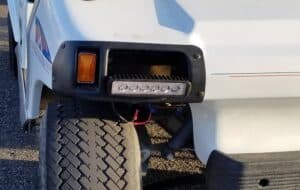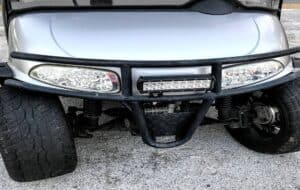If you own a golf cart, you know that nothing is more aggravating than having your lights go out regularly. Headlights and taillights are required to run the cart during low light hours or after dark, but golf carts are also required to have appropriately functional lights considered street legal in most jurisdictions across the country.
As a result, if a golf cart owner cannot get their lights to work correctly, they may not only be unable to use their cart after dark, but they will also most likely be unable to operate their cart throughout town legally. It can be a source of understandable annoyance.
Fortunately, if you find yourself in this situation, you’ve come to the correct spot. The most prevalent faults that can cause a golf cart’s lights to fail are described here.
Table of Contents
Causes of Faulty Headlights in Your Golf Cart

1. Golf Cart Headlights with a Blown Fuse
A blown-out headlight fuse is frequently linked to problems with a golf cart’s headlights. Your vehicle’s headlights will not receive the power they need to produce light if a headlight fuse blows. If your vehicle’s headlights were flickering or dim before they stopped operating, it’s almost sure that the problem is a blown fuse.
Lights that flicker or are substantially dimmer than usual are standard when this fuse begins to break. A bad or poorly soldered circuit connection could also harm your vehicle’s headlights.
2. Headlight Circuit Issues
Have you lately had your vehicle’s electrical system updated or repaired? If this is the case, a lousy circuit connection could be to blame for your headlight trouble. The headlight circuit is frequently impacted when the electrical cables on a golf cart are pulled out, changed, or repaired.
Your vehicle’s electrical system cannot send enough current to the headlight fuse when this circuit is weak or broken, causing the golf cart’s lights to fail.
If you installed your headlights and then took your cart to the dealer, they may confuse your work with factory work and disconnect and neglect to reconnect. If your wiring stops working after you’ve worked on the cart, double-check it.
3. Headlight Switch on a Golf Cart That Isn’t Working
A defective headlight switch is the third cause of a golf cart’s headlights not working. This switch may not receive enough current at times, causing it to fail. The golf cart operator will be unable to activate the vehicle’s headlights if this switch fails.
4. Golf Cart Headlight Bulbs That Have Blown
Finally, your headlight bulbs may have just burnt out. The majority of the time, they are simple to replace; buy new bulbs and replace them.
If you have LED bulbs, you may not change them and have to buy new headlights. If one of the lights works but the other doesn’t, it’s a dead giveaway that the bulb has burned out.
5. Your golf cart’s battery is dead
Some gas golf carts have an accessory battery, while some electric golf carts have a separate battery for radios and lighting, so they don’t drain the leading power bank. Always make sure that this battery is ultimately charged and that the voltage is sufficient to power your accessories.
6. Voltage Reducer Blown
Many electric golf carts contain a voltage reducer that reduces the voltage from 48 volts to 12 volts to power your illumination. These systems will eventually fail, and you will have to replace them. Take a multimeter and measure the voltage to check if it is putting out 12 volts to see if your voltage reducer is terrible.
How to Repair the Headlights on Your Golf Cart
Fixing your golf cart’s headlights is figuring out what’s causing the issue and then replacing the defective equipment or wiring. The steps below should help you figure out what’s wrong:
- Examine the connection between the circuits. Examine each wire in the circuit for damage.
- Examine the connections between the wires. Are they all adequately connected to produce the closed electrical circuit that is required for lighting?
- Check the quantity of electricity going to the lighting fuse with a multimeter. If there is no electricity coming from the fuse, it is most likely blown. Replace the fuse if necessary.
- If the fuse isn’t the issue, the next step is to inspect your vehicle’s lighting switch. Is it getting enough juice? If it’s getting enough power, but your lights aren’t turning on, the issue is most likely your switch.
- The switch is replaced.
- Your problem is most likely blown headlight bulbs if you have power to your lighting switch and power to your fuse.
- Replace the bulbs in your headlights.
- It’s probably time to replace or charge your battery if it’s dead.
Troubleshooting Faulty Brake Lights in Your Golf Cart
Typically, golf carts are not built with brake lights added by the manufacturer. Though specific models come with factory headlights and brake lights, it is more common for golf cart owners to have to install brake lights manually. Self-installation is frequently to blame for problems with a golf cart’s brake lights.

Loose wiring and faulty connections are the most common causes of brake light difficulties in golf carts. You are troubleshooting brake lights that you recently installed; check to see if your connections are firmly fixed and complete the electrical circuit. You might be able to add brake lights yourself if your golf cart lacks them.
If you are doubtful or not confident in your ability to complete the task, you should have the lights installed by a skilled mechanic. If the installation is not done correctly, lighting and electrical currents on a vehicle can rapidly become quite frustrating.
Frequently asked questions
Why do the headlight bulbs in my golf cart keep blowing?
Golf cart headlights will frequently blow if the wiring is improper or if the voltage is too high or too low. It’s a good idea to check the voltage of your incoming power to see if it’s 12 volts. Your voltage reducer may have failed, causing the bulbs to receive more electricity than they can handle.
If your golf cart’s headlight bulbs continue to blow after being replaced, you may have a wiring issue. Your golf cart’s headlight bulbs may continue to explode if your connections are crossed or your electrical circuit is not completed correctly. Examining your circuit wiring is the best way to diagnose problems connected with frequent headlight bulb blowouts.
Ensure you also double-check that your headlights are correctly connected to the battery connections on your cart. Only two battery terminals should be connected to the wiring for a cart’s headlights; any additional connections will cause the lamps to blow out immediately.
Why are the headlights of my golf cart dimming?
If the golf cart’s headlights have insufficient voltage or amperage, they will dim. Ensure your voltage reducer has enough amps to power all of your 12-volt accessories if you have one. If not, you may need to upgrade it.
Conclusion
Nothing is more aggravating to a golf cart owner than poor or broken headlights. Hopefully, by the time you get to the end of this article, you’ll have figured out what’s wrong with your golf cart’s headlights. Remember that your headlights are most likely not working because of a wiring problem. Begin by inspecting the wiring in your golf cart.
The lighting circuit is compared to the circuit diagram in the user manual for the cart. Make sure you’re buying the proper equipment when you start replacing defective parts on your golf cart. Only a few headlight bulb sizes and voltages are compatible with specific golf cart models.
